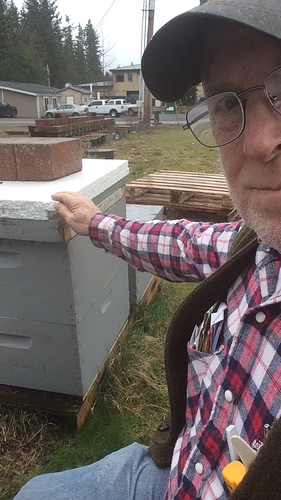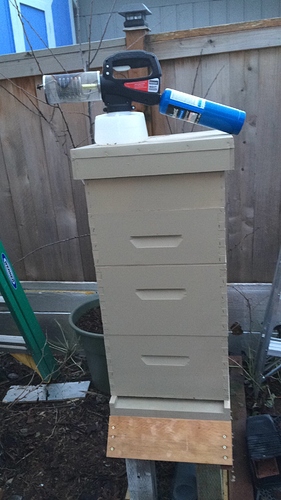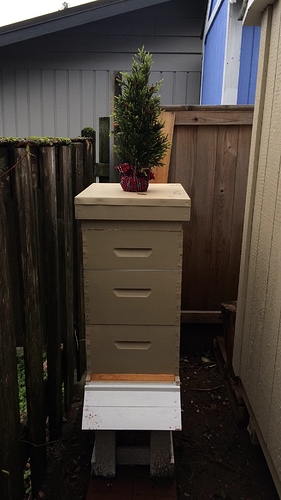Can these be stacked as the hive grows? Like adding a new box for them to fill?
Rich, simple answer is yes ! Other conventional honey supers can be added under or over your Flow-Super if that’s what you are referring too. Each region has different nectar flows n demands. Find out from others in your region do. The flow-frame is just another type of honey harvest tool. Normal beekeeping still the same ! Enjoy n good luck. Gerald
Not sure what you are wanting to stack. But the answer is yes in any case. 
You can buy more brood boxes and stack them below the Flow super. I don’t think I would stack more than one Flow super on a hive, although you could. There isn’t really much point - when it is full, you just turn the key and empty the frames. The bees can then refill it. I will be putting an empty medium box on top of the Flow super if the bees are slow to cap the honey. This gives a bit more space for ventilation and seems to help with capping.
Dawn
Great answer Dee ! Leaving the real Flow-hive stuff to you guys that have. Yah ! I would see little sense in multiple Flow-supers.
Thanks Gee! ![]()
As for brood box, yes you can add them as needed, I will add another once I see indication of a swarm.
The 8-frame deep will now be identical to the one that comes with the complete Flow hive.
http://www.beethinking.com/products/langstroth-deep-cedar-hive-box?variant=454238661
I would like to add a brood box before there are overt signs of a swarm (like queen cells at the bottom of the frame - that is a bit late to my mind). If the lower box has fully pulled comb on each frame, and a great brood pattern, I would add my second deep. But I am in California, your local practices may vary. However, Michael Bush (among others) has made a lot of observations which point to keeping space in the brood box as a method for swarm prevention. Just another point of view. 
Thanks for the explanations guys 
I am assuming you are talking about a second super, @Dawn_SD? Not a second brood box?
If it is a second brood, then wouldnt the bees fill up the second brood box, thus creating a never ending cycle of the beekeeper trying to keep space available and the bees filling up the available space?
If you mean a second super, then with a flowhive, wouldnt this be sort of pointless because you can always create space by emptying out a frame?
No, I mean a second brood box. Many beekeepers in the US run on 2 brood boxes. Your cycle will not be never-ending, because the queen is limited in how many eggs she can lay in a given time. See this thread for more thoughts on that:
So much to learn, and the bees know a lot more than we do! ![]()
Dawn
Quite, so a second flow super would be pointless. However, I have kept bees in traditional hives for many years, and I have often found that they have trouble capping the lowest super (= mature honey) unless they have space above. This is probably because good honey has a water content of less than 20%. The bees fan the hive to dehydrate the nectar. If there isn’t enough airspace to create a flow of air over the cells, the nectar won’t dehydrate and they won’t cap it. Why does this matter? Well, if the water content is more than 20%, the nectar can ferment - that is not honey… It might be OK for mead, or bakers’ honey, but it isn’t great quality, long-lived honey. So in my previous beekeeping, I usually have at least 2 supers, but with a Flow hive, the lowest would be the Flow super, the top would be a traditional super to keep the costs reasonable! ![]()
Philip,
As Dee wrote, here in most of the northern Hemisphere we do run hives with double brood boxes. (Most of us) … The double is very function up here especially in the colder northern states n regions. The upper brood doubles as a larger brood/worker force nursery as our active nectar/pollen season is not year around. As the summer/honey season come to an end (usually mid to late July in the Pacific NW) the the queens have throttled back n thus that upper brood become our winter honey storage for each hive. Here we hopefully winter over a hive (10 frame Lang) with approximately 80 pounds of honey in store.
Our Southern States can have a small winter nectar flow but each year is different. I live in the northern half of the U.S. so we use n need the double brood hive method. Above the double brood is our honey super (standard or Flow-Supers) … Hopefully I have made my method somewhat clear. Would be nice to not have the winter over n harvest that 60 to 80 pounds of liquid gold but not happening !  .
.
Take care n nice chatting or swapping ideas n ideas,
Gerald
Hey Gee, you can call me Dee if you want to… But the real @Dee is a different person!! ![]()
Just trying to avoid any confusion here. Dee makes much smarter comments than I do, I would hate for anyone to think that my ramblings are attributable to the real Dee. ![]()
Ha ha…not really. You have much more patience in your answers than me.
Also, could you imagine having to lift a full but uncapped flow super off to have a look at the box underneath!
You’d have to have a very strong assistant or a Warre lift
Gerald, I’m in NY state/ Do you think one deep and one medium brood box is enough to winter my bees or should I go with two deeps for the brood box ? Also do you provide a winter entrance near the cluster so that they can quickly take advantage of flight opportunities, and if so how do you do this ? Thanks.
Hi Nrose,
When i was a Jr n Sr High school beekeeping was my chosen project. We always ran a double deep. Each person n region can be different. I like using the same deeps so if I chose I can reverse the double boxes. The deeps also provide larger capacity for wintering over honey supply for the girls. At least this is the method I have chosen.
As for an upper exit …  I have an inner cover n a spacer that has a hole in it to help release moisture… The bees do use that for an addition exit for purging flights on our few milder days.
I have an inner cover n a spacer that has a hole in it to help release moisture… The bees do use that for an addition exit for purging flights on our few milder days. 

Nrose,
Here is my newest hives I will be adding Nuc’s this April.
with my 3 new hives I am going to try screened bottom board. I will see how this works at reducing mites, winter condensation, summer ventilation. The last/bottom photo is one of the new new hive set ups I built this winter in my woodshop. I am still working things out here. Rearing n caring for bees has changed a lot since my 1950 n 60’s experiences. Just giving you ideas what I n most do out here in Western Washington. Condensation can quickly kill our colonies if we don’t ventilate here. Our winter climate is so damp n rainy.Gerald
@Anon is not too far away from you (NJ) and I think he is very successful overwintering with 3 deeps for brood! Most people don’t use three, but I would use at least double deeps. One deep and one medium may not leave them with enough food… 
Great note Dawn… Best getting local ideas n knowledge. We are coasts apart n western Washington is much wetter but more on the mild during our weird weather changing climate. Our Spring has turned n flowers n buds popping already. We can still get flashes of cold n killing frost but I think winter is DONE for Puget Sound. It just whether we will have a wet, dry or in between Spring.
Thank you Gerald and Dawn. I know we might not get everything right the first time, but it;s nice to know what more established beekeepers are doing. What has and hasn’t worked.
I use 3 EIGHT frame deeps. I’m slowly phasing out 10 frame boxes but for the ones I do have I winter in 2 deeps and 1 medium. My studies have shown that they will pack the bottom box with pollen, the middle box will be brood and the top box will be mostly honey. I’ve wound up with larger honey harvests and I attribute that to earlier brood rearing due to available pollen and a full foraging force once the first Spring blooms open up.



